steering VAUXHALL COMBO 2016 Owner's Manual
[x] Cancel search | Manufacturer: VAUXHALL, Model Year: 2016, Model line: COMBO, Model: VAUXHALL COMBO 2016Pages: 189, PDF Size: 4.47 MB
Page 9 of 189
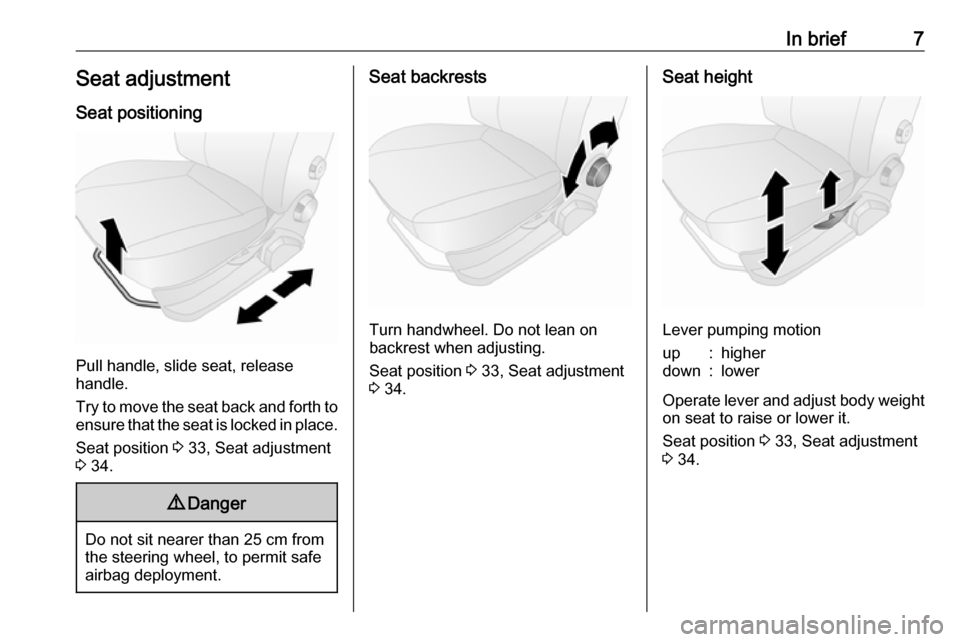
In brief7Seat adjustmentSeat positioning
Pull handle, slide seat, release
handle.
Try to move the seat back and forth to ensure that the seat is locked in place.
Seat position 3 33, Seat adjustment
3 34.
9 Danger
Do not sit nearer than 25 cm from
the steering wheel, to permit safe
airbag deployment.
Seat backrests
Turn handwheel. Do not lean on
backrest when adjusting.
Seat position 3 33, Seat adjustment
3 34.
Seat height
Lever pumping motion
up:higherdown:lower
Operate lever and adjust body weight
on seat to raise or lower it.
Seat position 3 33, Seat adjustment
3 34.
Page 11 of 189
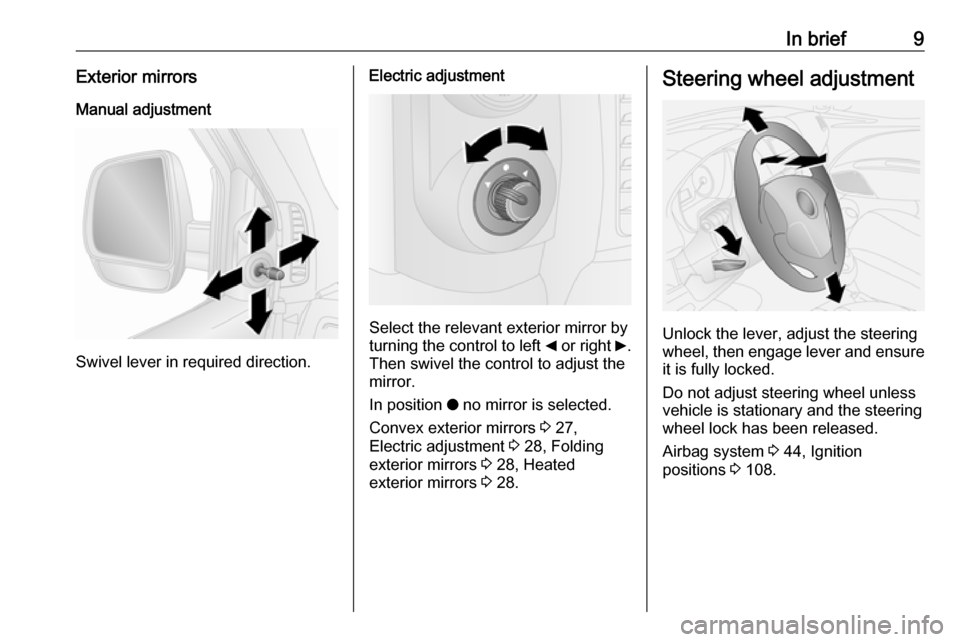
In brief9Exterior mirrorsManual adjustment
Swivel lever in required direction.
Electric adjustment
Select the relevant exterior mirror by
turning the control to left _ or right 6.
Then swivel the control to adjust the
mirror.
In position o no mirror is selected.
Convex exterior mirrors 3 27,
Electric adjustment 3 28, Folding
exterior mirrors 3 28, Heated
exterior mirrors 3 28.
Steering wheel adjustment
Unlock the lever, adjust the steering
wheel, then engage lever and ensure it is fully locked.
Do not adjust steering wheel unless
vehicle is stationary and the steering
wheel lock has been released.
Airbag system 3 44, Ignition
positions 3 108.
Page 13 of 189
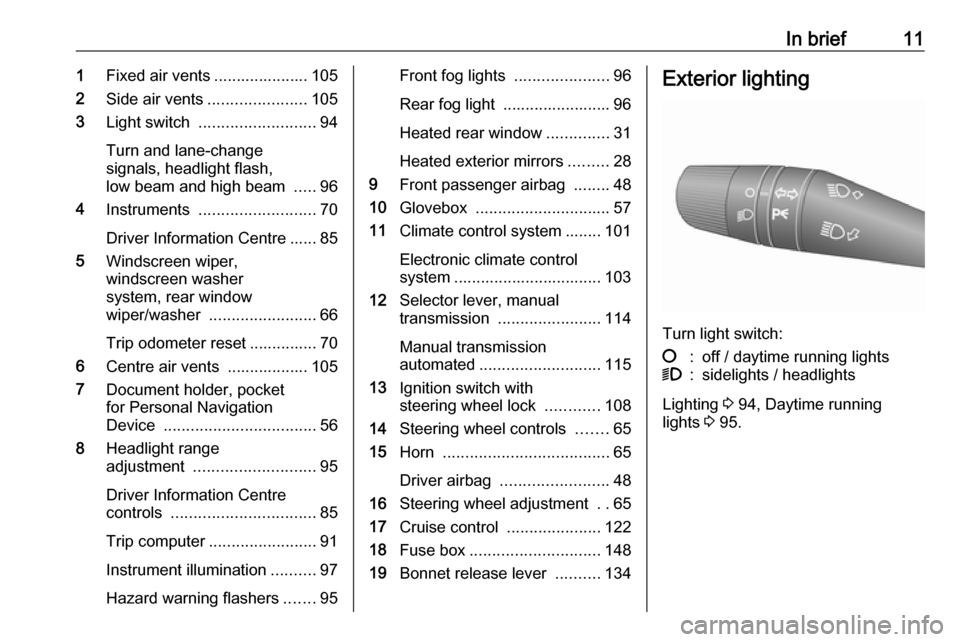
In brief111Fixed air vents ..................... 105
2 Side air vents ...................... 105
3 Light switch .......................... 94
Turn and lane-change
signals, headlight flash,
low beam and high beam .....96
4 Instruments .......................... 70
Driver Information Centre ...... 85
5 Windscreen wiper,
windscreen washer
system, rear window
wiper/washer ........................ 66
Trip odometer reset ............... 70
6 Centre air vents .................. 105
7 Document holder, pocket
for Personal Navigation
Device .................................. 56
8 Headlight range
adjustment ........................... 95
Driver Information Centre
controls ................................ 85
Trip computer ........................ 91
Instrument illumination ..........97
Hazard warning flashers .......95Front fog lights .....................96
Rear fog light ........................ 96
Heated rear window ..............31
Heated exterior mirrors .........28
9 Front passenger airbag ........48
10 Glovebox .............................. 57
11 Climate control system ........ 101
Electronic climate control
system ................................. 103
12 Selector lever, manual
transmission ....................... 114
Manual transmission
automated ........................... 115
13 Ignition switch with
steering wheel lock ............108
14 Steering wheel controls .......65
15 Horn ..................................... 65
Driver airbag ........................ 48
16 Steering wheel adjustment ..65
17 Cruise control .....................122
18 Fuse box ............................. 148
19 Bonnet release lever ..........134Exterior lighting
Turn light switch:
§:off / daytime running lights9:sidelights / headlights
Lighting 3 94, Daytime running
lights 3 95.
Page 18 of 189
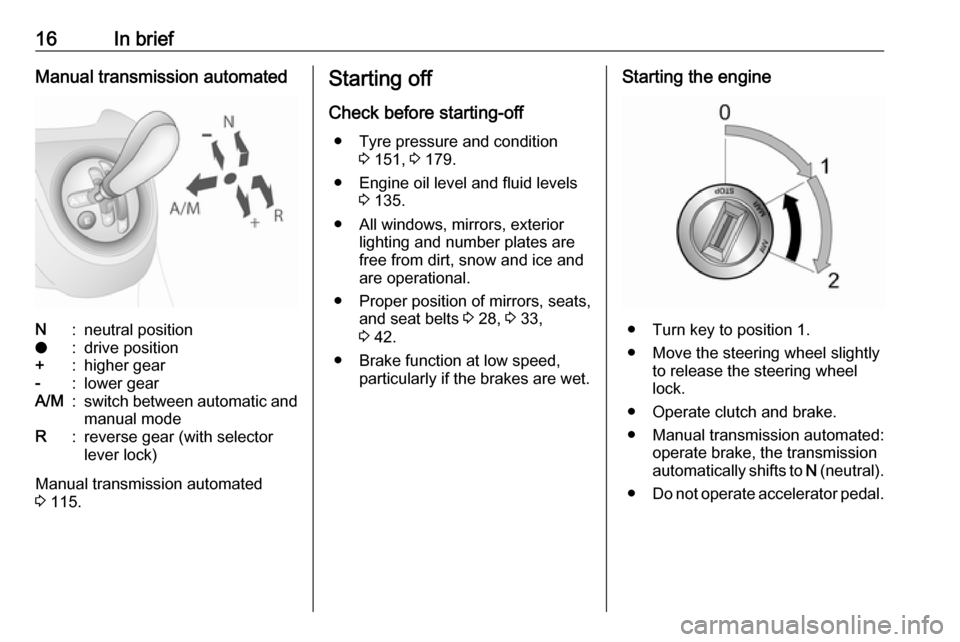
16In briefManual transmission automatedN:neutral positiono:drive position+:higher gear-:lower gearA/M:switch between automatic and
manual modeR:reverse gear (with selector
lever lock)
Manual transmission automated
3 115.
Starting off
Check before starting-off ● Tyre pressure and condition 3 151, 3 179.
● Engine oil level and fluid levels 3 135.
● All windows, mirrors, exterior lighting and number plates are
free from dirt, snow and ice and
are operational.
● Proper position of mirrors, seats, and seat belts 3 28, 3 33,
3 42.
● Brake function at low speed, particularly if the brakes are wet.Starting the engine
● Turn key to position 1.
● Move the steering wheel slightly to release the steering wheel
lock.
● Operate clutch and brake.
● Manual transmission automated: operate brake, the transmission
automatically shifts to N (neutral).
● Do not operate accelerator pedal.
Page 19 of 189
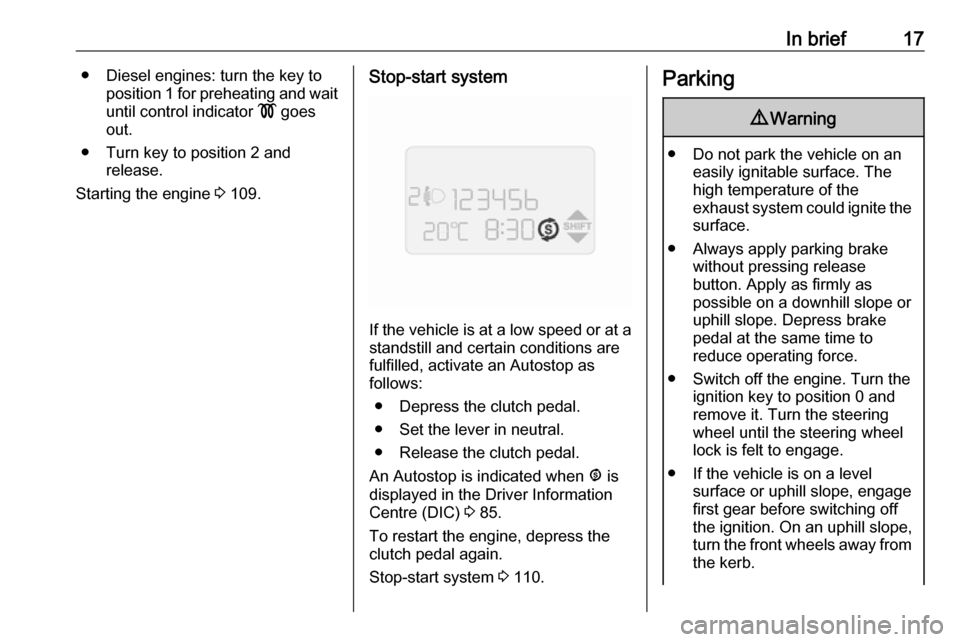
In brief17● Diesel engines: turn the key toposition 1 for preheating and wait
until control indicator ! goes
out.
● Turn key to position 2 and release.
Starting the engine 3 109.Stop-start system
If the vehicle is at a low speed or at a
standstill and certain conditions are
fulfilled, activate an Autostop as
follows:
● Depress the clutch pedal.
● Set the lever in neutral.
● Release the clutch pedal.
An Autostop is indicated when ^ is
displayed in the Driver Information
Centre (DIC) 3 85.
To restart the engine, depress the
clutch pedal again.
Stop-start system 3 110.
Parking9 Warning
● Do not park the vehicle on an
easily ignitable surface. The
high temperature of the
exhaust system could ignite the
surface.
● Always apply parking brake without pressing release
button. Apply as firmly as
possible on a downhill slope or
uphill slope. Depress brake
pedal at the same time to
reduce operating force.
● Switch off the engine. Turn the ignition key to position 0 and
remove it. Turn the steering
wheel until the steering wheel
lock is felt to engage.
● If the vehicle is on a level surface or uphill slope, engage
first gear before switching off
the ignition. On an uphill slope,
turn the front wheels away from
the kerb.
Page 35 of 189
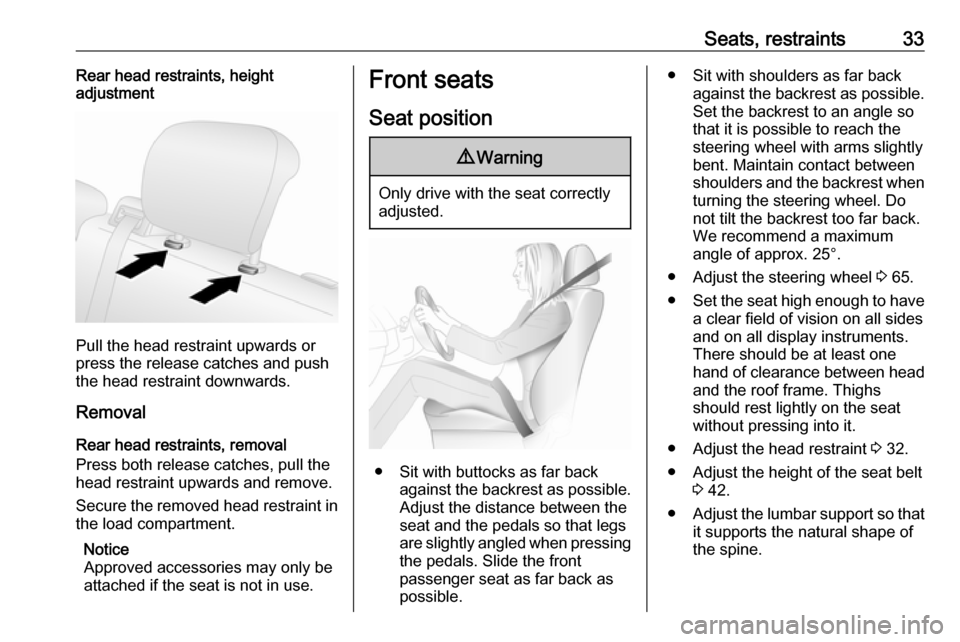
Seats, restraints33Rear head restraints, height
adjustment
Pull the head restraint upwards or
press the release catches and push the head restraint downwards.
Removal
Rear head restraints, removal
Press both release catches, pull the
head restraint upwards and remove.
Secure the removed head restraint in the load compartment.
Notice
Approved accessories may only be
attached if the seat is not in use.
Front seats
Seat position9 Warning
Only drive with the seat correctly
adjusted.
● Sit with buttocks as far back
against the backrest as possible.
Adjust the distance between the
seat and the pedals so that legs
are slightly angled when pressing
the pedals. Slide the front
passenger seat as far back as
possible.
● Sit with shoulders as far back against the backrest as possible.Set the backrest to an angle sothat it is possible to reach the
steering wheel with arms slightly bent. Maintain contact between
shoulders and the backrest when
turning the steering wheel. Do
not tilt the backrest too far back.
We recommend a maximum
angle of approx. 25°.
● Adjust the steering wheel 3 65.
● Set the seat high enough to have
a clear field of vision on all sides
and on all display instruments.
There should be at least one
hand of clearance between head
and the roof frame. Thighs
should rest lightly on the seat
without pressing into it.
● Adjust the head restraint 3 32.
● Adjust the height of the seat belt 3 42.
● Adjust the lumbar support so that
it supports the natural shape of
the spine.
Page 36 of 189
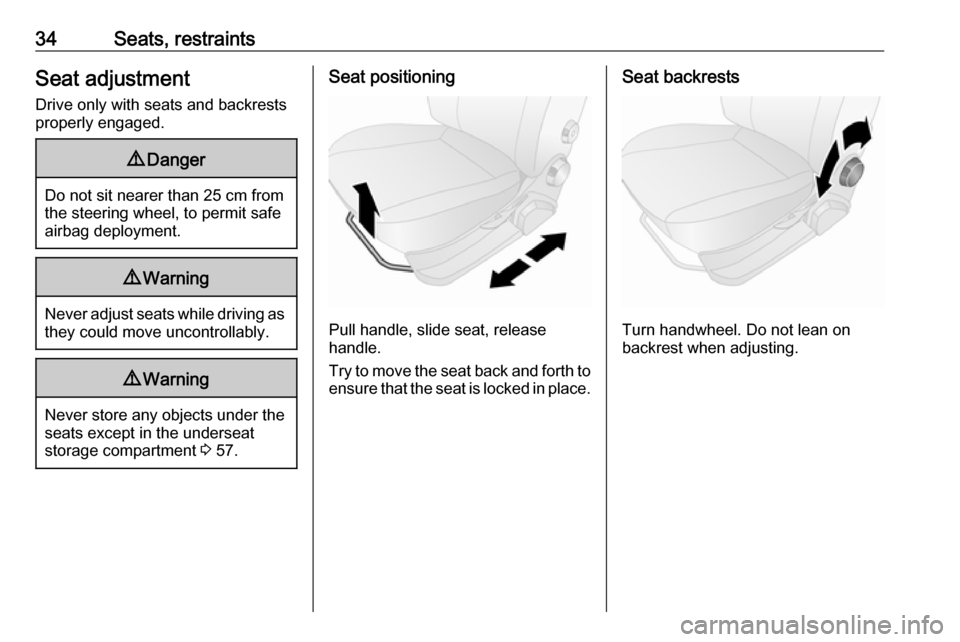
34Seats, restraintsSeat adjustment
Drive only with seats and backrests
properly engaged.9 Danger
Do not sit nearer than 25 cm from
the steering wheel, to permit safe
airbag deployment.
9 Warning
Never adjust seats while driving as
they could move uncontrollably.
9 Warning
Never store any objects under the
seats except in the underseat
storage compartment 3 57.
Seat positioning
Pull handle, slide seat, release
handle.
Try to move the seat back and forth to ensure that the seat is locked in place.
Seat backrests
Turn handwheel. Do not lean on
backrest when adjusting.
Page 47 of 189
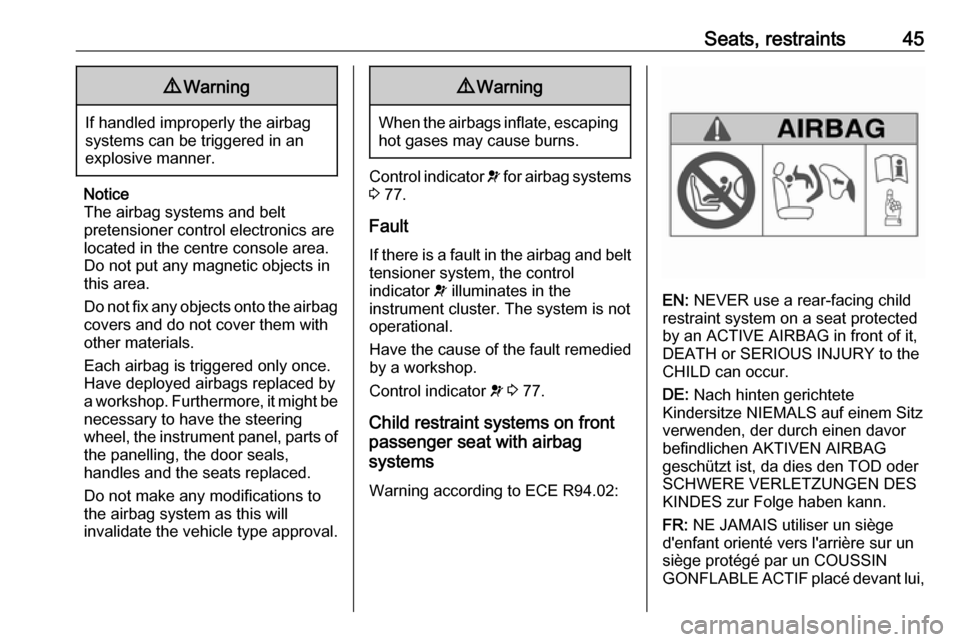
Seats, restraints459Warning
If handled improperly the airbag
systems can be triggered in an
explosive manner.
Notice
The airbag systems and belt
pretensioner control electronics are
located in the centre console area.
Do not put any magnetic objects in
this area.
Do not fix any objects onto the airbag
covers and do not cover them with
other materials.
Each airbag is triggered only once.
Have deployed airbags replaced by
a workshop. Furthermore, it might be necessary to have the steering
wheel, the instrument panel, parts of
the panelling, the door seals,
handles and the seats replaced.
Do not make any modifications to
the airbag system as this will
invalidate the vehicle type approval.
9 Warning
When the airbags inflate, escaping
hot gases may cause burns.
Control indicator v for airbag systems
3 77.
Fault
If there is a fault in the airbag and belt tensioner system, the control
indicator v illuminates in the
instrument cluster. The system is not
operational.
Have the cause of the fault remedied
by a workshop.
Control indicator v 3 77.
Child restraint systems on front
passenger seat with airbag
systems
Warning according to ECE R94.02:
EN: NEVER use a rear-facing child
restraint system on a seat protected
by an ACTIVE AIRBAG in front of it,
DEATH or SERIOUS INJURY to the
CHILD can occur.
DE: Nach hinten gerichtete
Kindersitze NIEMALS auf einem Sitz
verwenden, der durch einen davor
befindlichen AKTIVEN AIRBAG
geschützt ist, da dies den TOD oder
SCHWERE VERLETZUNGEN DES
KINDES zur Folge haben kann.
FR: NE JAMAIS utiliser un siège
d'enfant orienté vers l'arrière sur un
siège protégé par un COUSSIN
GONFLABLE ACTIF placé devant lui,
Page 50 of 189
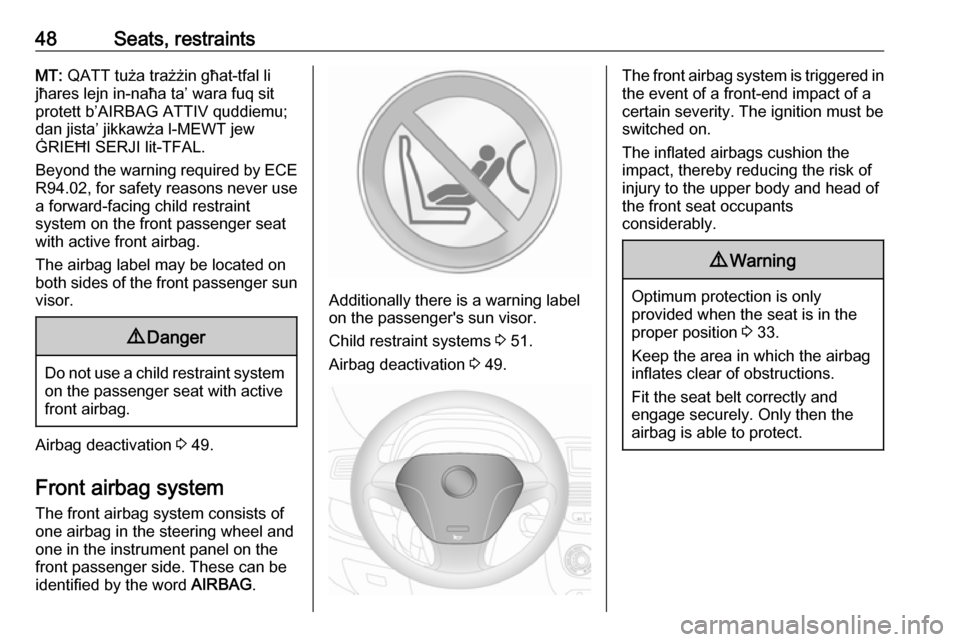
48Seats, restraintsMT: QATT tuża trażżin għat-tfal li
jħares lejn in-naħa ta’ wara fuq sit
protett b’AIRBAG ATTIV quddiemu;
dan jista’ jikkawża l-MEWT jew
ĠRIEĦI SERJI lit-TFAL.
Beyond the warning required by ECE R94.02, for safety reasons never use
a forward-facing child restraint
system on the front passenger seat
with active front airbag.
The airbag label may be located on
both sides of the front passenger sun
visor.9 Danger
Do not use a child restraint system
on the passenger seat with active
front airbag.
Airbag deactivation 3 49.
Front airbag system
The front airbag system consists of
one airbag in the steering wheel and
one in the instrument panel on the
front passenger side. These can be
identified by the word AIRBAG.
Additionally there is a warning label
on the passenger's sun visor.
Child restraint systems 3 51.
Airbag deactivation 3 49.
The front airbag system is triggered in
the event of a front-end impact of a
certain severity. The ignition must be
switched on.
The inflated airbags cushion the
impact, thereby reducing the risk of
injury to the upper body and head of
the front seat occupants
considerably.9 Warning
Optimum protection is only
provided when the seat is in the
proper position 3 33.
Keep the area in which the airbag
inflates clear of obstructions.
Fit the seat belt correctly and
engage securely. Only then the
airbag is able to protect.
Page 60 of 189

58StorageLoad compartmentRear storage
Roof bars
Do not exceed the maximum load
(which includes the weight of the bars) of 25 kg. Always distribute the
load evenly on the roof bars. The load must not obstruct complete closure ofthe doors.
Retighten the fastening screws on the
four brackets periodically.Caution
Do not use elastic lashings, e.g.
bungee cord. We recommend the
use of webbing straps.
Roof bars are designed to be fitted in
a specific position. Proper fastening
of the roof bars cannot be guaranteed if refitted in another position.
No materials (e.g. rubber, plastic)
should be placed between the feet of
the bars and the vehicle body, to
ensure proper fastening.
9 Warning
The use of roof bars may affect
steering and vehicle handling.
Removal
To remove the roof bars when not in use:
1. On one side of the vehicle, rotate handle below first roof bar
(located beneath the bracket) to
loosen, then slide handle inwards
towards centre of vehicle.
2. Repeat above step for the other side of the vehicle.
3. Push up roof bar to release from bracket on both sides and remove
roof bar completely.
4. Repeat above steps for the second roof bar.
5. Unfasten screws on the four brackets to remove the brackets
from the vehicle body.
Load compartment cover
Extendable load compartment
cover
Do not place any heavy or sharp-
edged objects on the extendable load
compartment cover.